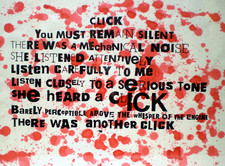
Speaking Out, The spoken word in artistic practice – symposium at Tate Modern on Saturday 6th Feb featured performance and presentations from Tomomi Adachi, Dani Gal, Caroline Bergvall, Nye Parry, Trevor Wishart, David Toop, Imogen Stidworthy, Brandon LaBelle, Inua ‘phaze’ Ellams and Oswaldo Macia.
Cathy Lane (of CRiSAP) presented the work of selected artists that feature in her book ‘Playing with Words, the spoken word in artistic practice’ (2009).
Tomomi Adachi performed a piece for voice and infra-red sensor shirt whereby the gesture acts as a “kind of modulator for the voice”. Sampling his own voice in real-time and modulating it via his movements within the shirt, he built up a complex and captivating cacophony. The putting on and removing of the shirt (including the resultant soundscape) formed part of a performance that, concluding with the neat folding of the shirt, provided aural humour that transcended linguistic boundaries.
Caroline Bergvall’s ‘Say Parsley’ discussed issues surrounding the 1937 linguistic ‘shibboleth’ in Haiti where the pronunciation of the Spanish word for Parsley: ‘perejil’ became a matter of life and death. Her work on ‘identity, gatekeeping, mishearing and imposed meaning’ made for an informative and thought provoking presentation.
It is said that prior to drowning, one’s life flashes before the eyes. Trevor Wishart’s ‘Globalalia’ put me in mind of how those last moments might be if the recollection was purely aural and what was flashing before the ears was every human vocal utterance ever made – a monumental piece.
Perhaps the most compelling work, Brandon La Belle’s ‘The Sound at the back of the mouth, almost’, was presented largely without sound. Questions such as ‘Where does my voice reside?’ and ‘What sounds does it make within the space of thought?’ were projected as white text on a black background and engendered an introspection that sought to ‘follow the voice in and outside the body’, aiming for the ‘inner voice as the paradoxical coupling of sound and silence’.
It struck me that contemplation of this inner voice seems prescient as the global communications network continues to grow and real aural arenas are replaced by virtual ones to which we, as a species, are (arguably) unsuited.
In Spaces speak, Are You Listening? (Blesser, B., Salter, L. MIT Press, 2007) Barry Blesser argues that humans are not designed for our current auditory environment. He quotes Robin Fox, from Conjectures and Confrontations, Science, Evolution, and Social Concern (Fox, R, New Brunswick, 1997)
“In some sense, (spaces) are human because they are human inventions. It is one of the paradoxes of an animal endowed with intelligence, foresight and language that it can become its own animal trainer: it can invent conditions for itself that it cannot handle because it was not evolved to handle them. ”
According to Blesser, “The aural architecture of our modern spaces trains those of us who occupy or inhabit them.”